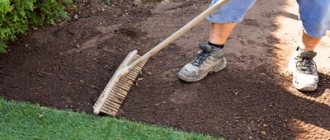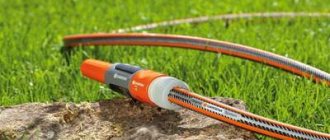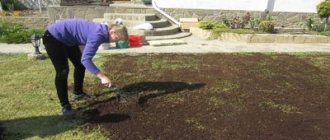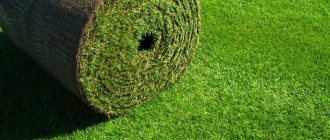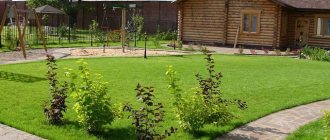If you compare a modern dacha and the one that existed 30 years ago, these are two significant differences. The Soviet one had a sea of garden beds, because it was simply impossible to provide the family with vitamins in any other way. Today there is an abundance of stores, which means you can create a paradise for relaxation at your dacha. And an indispensable attribute of the design was a lush, thick, soft lawn on which you can lie down, like on a carpet, and enjoy the floating clouds. But for the sown grass to please with its beautiful appearance, at least a year must pass, and you don’t want to wait for that. However, there is a simple solution - buy grown grass in a store. Laying a rolled lawn is quite simple and does not require any special skills, but within a month you can have picnics on it.
Specialized nursery companies are engaged in growing rolled turf. The period from sowing the seeds until the finished lawn goes on sale is three years. Most often, the seeds of the most resistant and easy-to-maintain grasses are used: meadow bluegrass and red fescue. In order for the grass to acquire density and density, it is grown for two years. During this time, the lawn has time to grow a strong root system, which will allow it to quickly take root when transplanted. Only in the 3rd year, the finished grass “carpet” along with the roots is cut into layers using special machines and mechanisms. The strips are immediately rolled up so that the root system does not dry out, and transported in coils to places of sale.
- 2 How many rolls will you need to buy?
- 3 Preparing the soil for laying
- 4 Rules for laying rolled grass
- 5 Front of work after planting the lawn
Preliminary work
In order for a beautiful grass covering to appear on the site, you first need to decide how it will be done. There are two options: sowing special seeds and using ready-made rolled lawn. And although preparing the base for a rolled lawn is practically done in the same way as with the seeding option, there are still some nuances. They relate to the composition of the soil that will accept seeds or grown grass rolled into rolls.
In general, the soil for a lawn should be fertile or neutral. The main criterion is at least 50% black soil. If seeds are used, then the remaining 50% should contain 10% sand and humus, as well as 30% peat. For the rolled version, humus is not required, because the base has already been grown. Therefore, 25% sand and peat are added to the chernozem.
But this is done when black soil is present. If the soil on the site is clay, you will have to add fertile soil to it. If there is sandy soil, sand is not used additionally. Only peat and humus are used. Therefore, before you begin preparing a site for rolled lawn or sowing seeds, you need to determine the type of soil available.
The soil for the lawn should be fertile or neutral Source diz-cafe.com
How many rolls will you need to buy?
Don't buy lawn offhand. If it is not enough, then you will have to buy more. The calculation technology is as follows: measure the parameters of the future site and multiply them. For example, length 6 m, width 5 m. Multiply 6x5. We get 30 sq.m. This is the area of your future lawn. If the site is flat, without bends or flower beds, then 5% of the area is added to accurately count the rolls. Those. to 30 + 1.5 m = 31.5 sq.m. If the future lawn is designed with bends, paths and other distortion of geometry, then 10% is added to the area, because the amount of waste will increase. Those. 30 + 3 = 33 sq.m.
Knowing the square footage, we calculate how many bays of grass we will have to buy. Area of one roll: 0.4x2=0.8 sq.m. This means that 1.25 bays will go per meter square of your site. Accordingly: 2 squares = 2.5 bays. For 10 squares there will be 12.5 bays, etc.
If you plan to lay a rolled lawn on an area with bends, paths or ridges, then add 10% to the area of the future lawn for waste
Peculiarities
To plant lawn grass, you need to allocate a certain area on your territory, as well as prepare it in advance. After a location has been chosen and the type and purpose of the lawn has been determined, the owners can begin preparing the soil for the lawn, as well as the seeds for sowing.
To prepare the ground for rolled artificial turf, you need to have special skills and knowledge. This work is as important as laying the foundation for a house. The better this stage of laying the lawn is done, the smoother and more beautiful the lawn will be, and there will be no problems with its subsequent maintenance.
Workers must be prepared for the fact that the technical process of preparing the soil for a lawn will take a lot of effort and time.
The work progress consists of the following stages:
- site preparation;
- selection of seeds;
- sowing and laying the lawn;
- care before the first mowing;
- aftercare.
The result of all the above measures should be a lawn with the following characteristics:
- perfectly smooth surface;
- homogeneous composition of herbs that correspond to the climatic zone;
- complete absence of weeds;
- have clear boundaries;
- successfully combines with the entire surrounding plant world.
No. 11. Caring for the lawn after laying it
The main secret of good survival rate of roll coating is high-quality moisture. When the laying work is completed, water the lawn generously at the rate of 1 bucket of water for every 1 m2 of surface. If you slightly lift one of the rolls by the edge, you will be able to see the wet turf and wetted soil in the area. In this case, watering is done correctly.
Over the next 2 weeks, the lawn must be watered every day, trying to prevent the soil from drying out. Ideally, automatic watering with sprinklers. It is better not to walk on the lawn during the first month, and for movement you can use boards, which should be removed immediately after the transition is completed. During this period, the turf grows together with the soil.
Further care looks like this:
- 4 weeks after laying, you can carry out the first cutting, but cut off only the tops, leaving the length of the blades of grass at 6 cm. Later, you can choose any desired length, but it is better to lower the blades in the lawn mower gradually;
- Watch for weeds and pull them out immediately. In the future, this problem will become less urgent, as the root system of lawn grasses will strengthen, become dense and will not allow weeds to pass through;
- Watering is carried out as the soil dries. In the absence of precipitation, focus on the frequency of watering 1-2 times every 10-12 days;
- Haircuts are carried out from April-May to October. During humid periods, mowing is carried out more often, in summer - less often, and at this time the lawn mower blades are set higher than usual;
- before wintering, it is necessary to trim so that the grass has time to grow at least 4 cm. In this case, the root system will be reliably protected from snow;
- before the onset of winter, the lawn is cleared of all debris and fallen leaves;
- from the second year after laying, mineral fertilizing can be carried out before watering.
A green lawn will fit perfectly into any landscape design and goes well with flower beds, flower beds, shrubs and even beds.
The easiest and fastest way to improve your own yard is to use a rolled lawn. In just a month you will be able to run around it, sunbathe and have cozy family picnics. Tags: Landscaping
Lawn site requirements
The first step is to determine the location for the lawn. When looking through different options, it is worth considering that the site should be well illuminated by sunlight.
Advice! When choosing a place for a lawn, you need to take into account what kind of irrigation will be used and its operating mode. Light shading near the site in the form of tall trees or a fence would not hurt. Otherwise, the scorching rays will burn the grass.
Another criterion is the cardinal direction. The microclimate depends on which side the site is located on. If the choice fell on a site located from the east or north, the lawn will be blown by a cold wind, from the west or southwest - by a damp wind. The southern direction is fraught with increased dryness, the northern - excess shade.
In this case, you need to focus on the type of lawn. A flat grass carpet is not dangerous from cold wind, but excess moisture and deep shade can destroy it. For tall lawn plants, it is better to choose areas that are not blown by the wind, otherwise the appearance will be spoiled due to the grass laid in different directions.
An equally important role when choosing a site is played by the type of soil and the level of groundwater. Too dense soils are lightened with a mixture of peat and sand, loose soils are enriched with fertile soil. When groundwater occurs close to each other, it becomes necessary to develop a drainage system.
What places are not suitable for a lawn:
- in the lowlands;
- in marshy areas;
- on a relief area with large slopes;
- in close proximity to tall trees.
Do not despair if the available free space for a lawn does not meet the above criteria. By adhering to the rules for preparing the soil for sowing grass, you can correct any flaws and shortcomings.
Lawn dimensions
According to the standard, grass turf is cut into fragments 40 cm wide and 2 meters long. These sizes may vary slightly from nursery to nursery. A universal lawn wider than 48 cm cannot be cut. These dimensions make the grass cover easy to cut, roll and transport.
When cut, the grass blades usually reach a height of 6 cm. The turf is cut up to 4 cm thick.
These parameters are mainly found in universal lawns. If the lawn is sporty, its cutting dimensions are different: length up to 15 cm and width up to one meter.
It is difficult to say how much a rolled grass covering weighs. The weight of the turf depends on the soil moisture. Average figures: 1 m2 of lawn weighs from 17 to 25 kg.
When transporting, pallets are used for convenience. One pallet can hold up to 62 rolls. This is enough to cover 50 m2 of a summer cottage.
Site cleaning
If the site was previously cultivated and is therefore in satisfactory condition, preparation work is reduced to a minimum. It’s another matter to lay out a lawn in an abandoned vacant lot. This option will be considered. The procedure outlined below is relevant for both seeded and rolled lawns.
They start by clearing away everything unnecessary:
- construction and household waste;
- trees, bushes;
- stones;
- branches, large chips;
- paths (removed to the base);
- flower beds
All of the above must be taken out. If you just dig it in, you won’t get uniform, dense turf. Over time, buried items will end up outside and render your lawnmower and other equipment unusable.
Stumps do not have to be uprooted. There are chemicals that can remove them without much effort.
Preparation for installation
One of the most important requirements before starting work on installing a rolled lawn is to clear the area of debris. Cleaning does not mean burying waste, but removing it from the site. Before starting work, it is necessary to remove all unnecessary bushes and trees on the site, uproot them, inspect and, if necessary, cure the plants that remain if any diseases are detected. It is necessary to take care of uprooting the rhizomes of perennial weeds. It would also be a good idea to carry out weeding using chemicals (one of the best is Roundup). After treatment with this product, the weeds will gradually begin to dry out until after 1-1.5 months they completely die off. After this, they begin preparing the soil to create a lawn. But still, such prevention cannot fully guarantee that weeds will not appear on the lawn in the future - there may be weed seeds in the soil that will germinate after some time. Some weeds die after mowing, but, alas, not all. For example, you should get rid of dandelions using a root digger. But you don’t need to devote all your efforts only to fighting weeds; when creating an English lawn, 15-20% of weeds are acceptable.
Planting a lawn in autumn
Summer is ending and it's time to mow the lawn. But does lawn care end there? What problems await owners of emerald lawns in the fall?
The first thing to do is to completely mow the lawn. It is advisable to leave only 4-5 cm of grass - this height will not allow the grass to freeze over the winter or attract diseases in the spring. Mowing should not differ in any way from the planned one.
If it is necessary to plant a lawn in the fall, then it should be done before the onset of cold weather - frosts can negate all your efforts.
Throughout the fall, until the first snow falls, it is recommended to carefully monitor your lawn. It is in the autumn, when the soil does not receive additional fertilizing, that the grass can get sick or begin to die. Particular attention should be paid to external changes - the appearance of yellow well-defined spots, different types of mold and other striking changes.
To prevent a lack of vitamins from causing significant harm, you should not forget about lawn fertilizer in the fall. You can add any complex product that will prevent the soil from depleting and the grass from dying.
What time of year should I lay commercial turf?
You can lay lawn sod at any time of the year, except in winter. Manufacturers claim that installation should begin in early spring. And that even laid out rolls of grass will take root in late autumn. But there are certain difficulties in laying a lawn in autumn and summer. If possible, it is better not to import rolled lawn at this time. The optimal time is the end of March - the beginning of April, when the soil has thawed and excess moisture has gone into the ground. Spring is the time when grass grows well. Planted turf in the spring will create a thick green carpet at the dacha this summer.
In October and November, the lawn is laid only if the weather remains warm and mild for at least two to three weeks. During this time, the plants will have time to grow and take root in the soil. The grass will grow until the temperature drops to +50C
. And if the shoots have time to take root well, then the lawn will go into winter prepared and will overwinter normally. Autumn installation threatens with difficulties in the spring: it will be difficult for young shoots to break through last year’s grass. As a result, the lawn surface will be thick in some places and bald in others.
During the summer months, installation is also challenging. Replanting plants is always stressful. And in the summer, when the air temperature is high, it is especially difficult for grass to take root. There is a risk that some of the shoots will not take root. If you need your lawn in a hurry during the summer, be prepared to water it twice a day. This will help the turf to blend well with the soil.
Preliminary soil preparation for the lawn
| Step 1. Mark the area and determine the shape and size of the lawn. What is needed. Wooden pegs and polyethylene cord. What is being done . Pegs are driven into the ground around the perimeter of the future lawn. The step between the elements is from 60 to 100 cm. A cord is stretched between them for reference | |
| Step 2. Preparing the ground for the lawn is done in the fall. What is necessary . Shovel or walk-behind tractor with plow. What is being done . The entire area under the lawn is dug up to a depth of 20-25 cm. No additional work is required | |
| Step 3. Soil cultivation What is needed . Walk-behind tractor with cultivator or motor-cultivator. What is being done . The soil is cultivated to a depth of at least 15 cm. The more thoroughly you loosen the area under the lawn, the easier the next stages will be. | |
| Step 4. Covering the prepared area What is needed . Black agricultural film. What is being done . The film is carefully laid on the soil and pressed with any suitable objects so that the wind does not blow away the shelter | |
| Step 5. Weed control What is needed . Any special drug for weed control. The quantity depends on the area being treated. What is being done . Prepare the solution as indicated in the instructions, follow the proportions. Treat the area under the lawn, it is best to use a garden sprayer | |
| Step 6. Rest under steam What is being done . The soil should last 2-3 weeks. Do not walk on it or carry out any work |
We figured out how to prepare the ground for a lawn with our own hands. But this is only the first part of the work; then a number of actions are performed.
Tips for growing rolled sod
Nursery specialists grow ordinary seed grasses by sowing seeds in large areas of turf laid on a strong metal base, watering, fertilizing them, and trimming them as they grow. After two to three years, the grasses, along with the thick turf, are cut off in small fragments and rolled into rolls. In this form they are delivered to the buyer.
Then the finished lawn is spread on the prepared area. The roots of herbs from the rolled sod grow into the soil. And after 10-15 days, a full-fledged green coating pleases its owner.
Let's take a closer look at the whole process that seeds and then plants go through in the nursery and at the dacha before becoming a decoration of the dacha.
The cultivation of mature grass is carried out in nurseries using special equipment. From the moment of sowing the seeds until the moment of cutting the turf, approximately 1.5-3 years pass.
It is believed that it is best to buy lawn that has been grown in a nursery for three years. This turf has a well-formed root system, allowing it to quickly adapt to a new location. And the grasses themselves grow close to each other, without forming empty space.
There are several technologies for growing grass. Seeds are planted in two ways:
- Using a mesh
. First, a plot of land is prepared, then it is covered with a mesh made of geotextile, agrofibre, and felt. Then the seeds are sown on the mesh. The roots of the seedlings securely entwine the mesh. As a result, a durable grass covering is formed, which is easy to cut, roll and transfer to a new place of “residence”. - Gridless cultivation
. When sowing seeds, a net is not used. The roots of densely sown grasses themselves are intertwined so that they form a durable cover. The turf allows it to be cut, twisted and transported. It is worth noting that growing such a lawn is much more difficult. Transportation is also fraught with difficulties. Only fans of natural coverings prefer this particular rolled lawn.
The technology is the same at all turf nurseries. Of course, everyone has their own little secrets and life hacks. But the basic growing process looks like this:
- Soil preparation. The soil is loosened with a cultivator or plow, breaking up large clods. The remaining small lumps are broken up with a harrow.
- The soil is treated with herbicides to destroy weeds.
- When they plan to grow a lawn on a net, it is laid out at this stage. When laying the mesh, the size of the future lawn and irrigation features are taken into account.
- The prepared area is sown with herbal mixtures.
- After the seedlings appear, they are cared for in the same way as other plants: watered and fertilized.
- As the grass grows, mow it. As a result, the herbal mixture grows in a dense carpet, intertwining its roots even more.
- The lawn, ready for cutting, is cut into layers, rolled up and transported to the customer.
The turf is cut off on the eve of transportation. It is best when no more than 24 hours pass from cutting the layers to laying them in a new place.
If the time increases, there is a risk that the roots will begin to dry out, which will lead to the death of the lawn. When the turf is cut and delivered, but there is no way to lay it, the rolls are abundantly moistened.
Step-by-step actions
When the choice of lawn material has been made, it is necessary to decide on the size of the area on which you plan to make a lawn. The following is done:
- Marking the site and cleaning it.
- Leveling the area.
- Digging.
- Forming the required percentage of soil, applying fertilizers, and performing drainage.
- Seal.
Cleaning and leveling
Preparing the soil for a lawn begins with cleaning the designated area. If there is grass growing on it, it needs to be mowed. There may also be old bushes, trees, and stumps. In order for the site to have a harmonious appearance, you need to not just cut down their visible parts, but uproot everything along with the roots. This is labor-intensive work, but it will bear fruit in the future.
Attention is paid to the degree of surface evenness. Sometimes there are elevation changes, bumps, and ruts. In this case, it is better to plan the area so that it becomes uniform. If desired, you can make a slope, but it must also be uniform. This option is convenient in places where a lot of moisture accumulates. All protruding parts of the surface are removed.
The slope should be uniform Source fresh-deko.ru
If you have regular grass cover, you need to decide how to remove it. This can be done in two ways. The first is to remove a small layer of turf from the top layer of soil. It is advantageous in that this mixture of earth and grass will produce good rotted soil in about six months. To do this, the turf must be laid in a remote place on the site.
The second method is the use of modern chemicals that destroy not only the upper part of the plants, but also their root system. It is more reliable because in the first option the roots remain in the ground. They are removed during further work with the soil. But the chemicals do not work immediately. It takes time for them to permeate the entire system. This usually takes several days, after which all that remains is to remove the dry residues. The disadvantage of the second method is that there is a waiting period before sowing lawn grass. It must be at least three weeks.
The grass cover needs to be removed from the site Source plumbber.ru
Digging
The next stage of cultivating the soil for a lawn is digging. It is mandatory even if the site has been cultivated every year. Then a single-tier option will be sufficient. It consists of removing and turning over a layer of soil, the depth of which is approximately equal to the bayonet of a shovel. At this time, the roots remaining in the soil are additionally removed. If this is not done, they will grow through the cultivated lawn.
The two-tier digging option is used in areas that have not been previously treated. It is also used if the treatment was carried out a long time ago or the soil is heavy. This is done in the following sequence:
- A furrow is dug across the area of the site. The depth is the same as for single-tier digging. The earth is moved to the side.
- The remaining lower layer of soil is loosened . This can be done using a pickaxe or pitchfork.
- The next furrow is dug parallel to the first . The soil removed from it is placed in the initial furrow.
- The process is repeated until the end of the section is reached. The soil removed from the first furrow is placed in the last furrow.
Digging up the area Source pinterest.ca
In both digging options, large lumps of earth are broken. When it is completed, the ground is leveled with a rake. At this time, the process of removing the roots of plants that were previously on the site continues. The end result should be a flat piece of clean land.
Soil formation, drainage
The upper part of the area allocated for the future lawn should have the soil described at the beginning of the article (chernozem, sand, peat, humus). It is recommended that its layer be about 15 cm. When preparing the soil for a rolled lawn, the thickness can be less - 12 cm. This is due to the fact that the rolls are ready-made turf mats. If the underlying soil is loose enough and is a clay-sand mixture, lawn grass will grow well. If sand or clay predominates in it, additional drainage is required. To do this, before pouring the fertile top layer, small pebbles and gravel are laid. The thickness of this part is usually 5 cm. If the soil is too clayey, the thickness increases to 15 cm. In this case, additional sand is poured between the pebbles. It is allowed to replace it with small screenings. If there is always a lot of moisture in the area, drainage ditches are made. In the most difficult cases, special pipes are laid to drain the water.
Thanks to the drainage system, the lawn will be protected from waterlogging Source fruittree.ru
Fertilizer application, compaction
Before moving on to the final stage of preparing the land for the lawn, it is necessary to add fertilizer to the top layer of soil. The main one is phosphorus, thanks to which nutrients accumulate in plants, their root system is strengthened, and new shoots are formed. Nitrogen is also important to speed up growth. Additionally, potassium is added, which makes the grass resistant to diseases and adverse environmental conditions.
When this work is completed, the area is watered so that the earth settles. Then you need to wait until it is completely dry and start compacting the soil. Garden rollers are used as a device for this. This is an important stage, especially if seeds will be sowed. Plants take root better in dense soil. After all the manipulations carried out, the area should look like a flat, clean field and resemble a pie with fine crumbs sprinkled on top.
The main fertilizer is phosphorus Source hortikultura-araucaria.hr
Rolled lawn in the store: checking the quality
All grass coves offered in stores look the same. They are cut into strips, two meters long and 40 cm wide. Usually the length of the stems reaches 6-7 cm, and the layer of the root system is more than 2 cm. One bay has a very noticeable weight - within 25 kg.
A quality lawn has uniform thickness of turf and grass along the entire length of the roll. This is checked by the side cut
But these parameters are not enough to determine the quality of the lawn. To check whether the cultivation technology has been violated, you need to roll out the roll of turf and look at the cut layer on both sides.
Please note the following:
- Are there any weeds among the blades of grass?
- How uniform is the grass, are there any bald spots (spots where the grass has not grown).
- Look at the rolled out coil from the side: the cut layer should have the same thickness.
- Grab the edge of the roll with both hands and pull it slightly toward you. If the grass gives way and begins to lag behind the main layer, it means that the roots of this grass are poorly developed. This material does not take root well, so it is better to avoid it.
- Lift up a piece of the roll and look at the quality of the roots. They should be intertwined as tightly as possible. The fewer gaps between them, the better.
Who needs to level the ground and why?
The first thing to do is to level the surface, otherwise you won’t get a perfectly smooth carpet. There are several reasons for leveling the land on a site. You can determine the degree of their importance for yourself, but you cannot ignore them. So, why level the ground:
- The grasses used for lawns grow well on a flat surface.
- A lawn without hills ensures uniform watering. Water does not drain from the even green carpet, all the grass receives enough moisture, and no overdried areas are formed.
- The hilly terrain distorts the flow of sunlight, the grass grows unevenly, forming lush thickets in one place and stunted growth in another.
- A smooth lawn looks aesthetically pleasing, serves as an elegant decorative element, and favorably emphasizes other elements of the garden.
- It is more convenient and easier to care for a lawn without flaws, especially mowing the grass.
Kinds
Lawns in rolls differ only in the type of vegetation, which also determines how wear-resistant and beautiful the coating will be. All types are conventionally divided into decorative, sports and special. It is necessary to choose a lawn taking into account its functional purpose. If it will be used for outdoor activities or physical activities, then a sports one is needed. The purpose of decorative is primarily aesthetic; it is not able to withstand friction and quickly recover from damage.
Sports
Lawns for sports must be resistant to trampling and abrasion. The vegetation is especially dense for them. Preference is given to herbs that grow quickly in any weather conditions.
For football fields, a mixture of red fescue, bent grass, and meadow grass is planted. To equip tennis courts, you need a smooth surface with short-cropped vegetation, so most often they use lawns made from one type of cereal grass. Golf courses are seeded with a fescue mixture.
Decorative
To make roll-up lawns of this type, more delicate plants are used. Most often these are mixtures of herbs that provide a velvety green coating throughout the season. Some decorative lawns are moderately resistant to trampling, while others are intended solely for decoration.
Types of decorative roll lawns:
When choosing a decorative lawn, you need to consider whether it will be used for recreation or simply to decorate the landscape, as well as evaluate the possibilities of regular vegetation care, climatic conditions and the cost of the material.
Special
There are special types of rolled lawns; they are used to solve narrow problems. For example, strengthening slopes, absorbing harmful substances from the air, reducing noise levels. Such coatings are not needed for a home garden or park; they are used on roadsides, near industrial enterprises and airfields.
How to properly dig up soil for a lawn
If it is decided to leave the existing soil, it is carefully dug up. At the same time, grasses and their roots that are not damaged by herbicides are removed, and humus and other necessary additives are added.
There are two methods for digging up soil:
- single-tier. It is used in cultivated areas, that is, previously occupied by vegetable beds or flower beds. The soil is dug up in the usual way to a depth equal to the height of the shovel bayonet;
- two-tier.
The two-tier option is more labor-intensive; it is used if:
- the area has not been cultivated before;
- the soil is too heavy and needs to be diluted with a peat-sand mixture;
- the fertile layer is too light and needs to be diluted with loam.
Two-tier digging is carried out as follows:
- within a narrow strip across the site, remove the top layer of soil using the bayonet of a shovel and put it aside;
- in the resulting furrow, carefully loosen the bottom, that is, the lower layer of soil, with a pitchfork or pick;
- dig another one along the furrow, pouring the extracted soil into the first furrow;
- loosen the bottom of the second furrow and fill it with soil extracted at the very beginning when forming the first furrow;
- The entire area is treated in the same way.
Digging is accompanied by the following actions:
- add compost, rotted manure and, if necessary, a mixture of sand and peat or loam to the soil;
- remove weed roots;
- break large pieces of earth.
Soil structure of the earth
Next, you should think about how to make the soil composition optimal for lawn grass. It grows well on light, medium-fertile soils.
If the soil on the site is not such, cut off the top layer of soil and replace it with a mixture of the following components:
- loam: 1 part;
- manure: 1 part;
- peat-sand mixture: 2 parts.
This is ideal, but it is very complicated. A less labor-intensive method: add the listed components to the existing soil when digging.
Methods for optimizing soil composition:
- heavy soil (high content of clay inclusions) is diluted with peat and sand;
- sandy and sandy loam - loam;
- peat and humus are introduced into infertile soil;
- soil with low acidity (less than 5-5.2) is enriched with chalk;
- superphosphate is added at the rate of 50 g/m2 (for all types of soil).
Required thickness of the fertile layer:
- for rolled lawn: at least 20 cm;
- for seeded lawn: 25-30 cm.
It is allowed to use peat-sand mixture in its pure form as planting soil. But then you will have to constantly fertilize, since such soil does not contain nutrients.
Tamping
Lawn preparation includes tamping. For future sowing of seeds, the soil must be compacted. Compact the dug up and leveled soil with a hand roller weighing approximately one hundredweight. Although you can use a simple board. No one should be allowed to roll the earth after or during rain. Walking on compacted and compacted soil is not allowed. Carefully compacted soil will allow the seeds to lie evenly in the ground, and this in turn will help them swell and sprout.
It is better to do tamping in dry weather.
We have figured out how to compact the soil under the lawn, now let's move on to the next final stage.
Main stages
Creating a lush and evenly greened carpet with your own hands is not an easy task. It is better to do the work by a master who is familiar with the technology of creating decorative green lawns.
Cleaning
If the site has been previously cultivated and is in satisfactory condition, cleaning work will be minimal. More work will have to be put into laying a lawn in a neglected area. An overgrown area in a dacha or virgin forest land will require a lot of effort and the following actions:
- disposal of construction and household waste;
- removing stones and branches;
- uprooting trees and bushes;
- removing paths and flower beds right down to the base.
All of the above unnecessary items must be taken outside the site. If the latter are buried, over time, debris and vegetation will end up on the surface of the lawn, ruining the equipment that will function on it. It is advisable to uproot the stumps, but you can also use special means. Treatment with chemicals will help eliminate them without effort.
If you want to create a green lawn, you need to remove all weeds from the area. This can be done mechanically or chemically.
It is recommended to treat with herbicides one and a half months before sowing the seeds.
Alignment
The next time-consuming process is leveling the base. If the site of the future lawn has bumps, heights, or ruts, then planning must be done in advance, thanks to which the area can become uniform. If desired, a uniform slope can be created on the lawn. The latter option is considered ideal for places with large accumulations of moisture.
Fertilizer application
Before you begin the final stages of preparing the soil, it needs to be fertilized. To do this, phosphorus is added to the soil, which helps strengthen the root system and the formation of new shoots. Nitrogen fertilization accelerates crop growth. It is also additionally worth introducing potassium into the soil, which forms the resistance of vegetation to various diseases.
Digging
To further prepare the site, the site needs to be dug up. This event is necessary even if the area is treated annually. They dig up the soil by immersing and removing the tool on the bayonet of a shovel. In parallel with this procedure, it is worth removing the entire root system present in the ground.
Two-tier processing is carried out in those areas where there were no previous treatments. Heavy and neglected areas are dug up with this sequence.
- A furrow 1 spade deep is dug across the area. In this case, all the soil must be removed to the side.
- The lower soil layer is loosened with a pitchfork or pick.
- Dig a furrow parallel to the one already created. In this case, the extracted soil is placed in the first furrow.
- The procedure is repeated several times until the entire area is dug up.
During the soil digging procedure, it is imperative to break up the earth lumps. After completing the work, the ground should be leveled with a rake. The result of this stage should be a plot with a clean piece of land.
Leveling the surface
A perfectly flat, flat base is necessary to lay a roll-shaped lawn on it. For this reason, the worker will need to start leveling the area . If you skip this procedure, then after mowing the lawn the length of the grass will be different, namely long in the depressions and short on the hills. If there is a slight difference in altitude on the site, then you can level the ground using a rake.
The presence of pronounced unevenness in the terrain requires the transfer of soil from heights to lowlands. When performing such work, you should avoid mixing parts of the earth. In some cases, there is a need to add substrate, terracing, and strengthen each of the sites with retaining walls.
Arrangement of the drainage system
To ensure high-quality seedlings on the site of the future lawn, it is necessary to properly install a drainage system, observing the requirements. Installation work must be carried out before laying the grass. The elements of lawn drainage are the following:
- underground porous pipes that suck up liquid when there is an excess of it in the ground;
- a network of pipes arranged in a herringbone pattern, where in the center there is a water drainage channel, leading into a ditch from below.
Stages of arranging a drainage system.
- Leveling the trench bottom with sand. Laying a sand cushion with a layer of 0.15 m, as well as gravel with a fraction of 3-4 cm.
- Laying the pipe and then filling the area with gravel. In this case, the pile of gravel on the pipe should be about 0.15 m. When performing work, the master must remember that the level of gravel should be 0.05 or 0.10 m below the surface of the lawn.
- Laying the plant soil and bringing the ends of the pipes onto the plane of the lawn.
According to the requirements, the distance between the hoses on clay soil should be 5 m, on sandy soil - about 8 m. The angle of entry of the pipes into the central outlet channel should be equal to 60 degrees. If the soil is clayey, then the pipes should be laid at a depth of 0.6 meters. In this case, it is worth using pipes with a diameter of 10-15 cm.
If drainage is installed on the territory of the future lawn, then you can start arranging an automatic irrigation system, which includes the following elements:
- a controller capable of programming the volume, time, and frequency of watering;
- sprayers;
- a sensor that monitors soil moisture;
- solenoid valves;
- systems that turn and branch pipes;
- nozzles;
- water intake columns;
- pipes.
To install an irrigation system, you will need to perform the following measures.
- Dig a trench for pipes. Their depth should be from 0.3 meters.
- Lay pipes and nozzles. After this, it is worth installing the sprinklers, controller, valves and other parts of the system. Having completed this stage, the technician must conduct a test run of the irrigation system and inspect the facility for leaks, defects, and breakdowns.
- If the irrigation system is installed correctly, you can begin filling the area with sand. It is worth laying soil and a layer of soil on top of the sand layer.
Seal
The compaction of the area is carried out using a special tool - a roller. Its basis is a hollow drum. The skating rink has a small weight, so it can be easily transported. If necessary, the weight of the equipment can be increased by pouring water into the drum hole. To compact and compact the soil under the lawn well, it is better to use a roller weighing more than 100 kg. If such a tool is not available, then the procedure is carried out by moving throughout the entire territory in small steps. After completion of compaction work, it is recommended to loosen the top layer of soil with a rake.
The finished area is left for several months so that the substrate can settle. Over time, subsidence will be noticeable, which can be corrected by adding more soil or cutting it off. A lawn is not a cheap pleasure; it requires a lot of financial, time and labor effort.
If the lawn is well-maintained, it can serve its owners for many years. Therefore, if you want to decorate your territory with a fresh green carpet, you should approach all measures to prepare the soil for arranging a lawn responsibly.
To learn how to prepare the soil for a lawn, watch the following video.
What tools are needed?
When starting to arrange your lawn, you need to prepare the following tools:
- bayonet shovel;
- a wheelbarrow for removing garbage and excess soil formed after leveling the hills;
- tape measure, cord for marking the area, level;
- weed removal tool;
- soil compaction roller;
- mineral fertilizers;
- herbicides.
If necessary, you will also need to purchase geotextiles and bring gravel and sand to the site to create a drainage layer.
Work immediately before sowing seeds
After the work has been done, we can say that the area for planting a lawn is almost ready. Only small nuances remain. Immediately before sowing, you need to sprinkle complex fertilizer on the soil and rake it . You will also use a rake to remove any unevenness and debris that has arisen again. The area for the lawn should have a grainy surface with a dense middle.
If you can wait a little (a month or two), then the area prepared for planting can be allowed to stand fallow. This will make it possible to prepare the area for sowing even better, because after fallowing the soil shrinks even more, and this, in turn, reveals new defects that can now be eliminated. Preparing the ground for a lawn involves a lot of work and it will be a shame if it turns out that you did not clear the ground of weeds very well, and fallowing the ground will help cope with this problem, because two months after resting, weeds that you missed will certainly appear on the ground, and they can still be removed before sowing.
Now all that remains is to loosen the soil again with a rake and sow the seeds
Lawn base
The base for the covering is an essential part of the entire grass installation process. Usually sand or calendered black geotextile is placed under the roll. Why is it needed? With its help, you will get rid of various weeds that accidentally fell on your plant plot - the lining simply will not allow them to germinate. How to lay rolled lawn - basic principles:
- Geotextiles can only be applied to already cleaned and prepared soil.
- Rolls are unwound overlapping
- Don't forget to fasten them
- Either you sow seeds on the base, or you place purchased rolls of lawn on it
If weeds remain under the layer, then their further growth and reproduction stops, turning into useful humus for the soil. Using geotextiles, you can easily level any uneven areas, strengthen small slopes, holes, and slopes. As mentioned above, it is overlapped by up to 15 centimeters, and the maximum distance between the parts is 2 meters, which must be fastened with anchors.
Nothing will happen to the base until it interacts with the soil and root system of the lawn. Next, sand or its substitute is covered with high-quality soil up to 4 centimeters in thickness. Then you can lay the lawn.
Digging up soil
. Next you need to return the soil to its place - now it will be on top of the sand
- pegs
- ) and fold it at the edge of the plot (using a shovel and pitchfork). After this, move the earth from hills to holes (usually there are many such places). And the last step will be to return the top layer of soil to its place and level it (here you will need a rake). After carrying out the above actions, let the area stand (
- First, you need to divide the area into
- for stranamasterov.net
Prices and terms
The cost of performing work to prepare the selected area for a lawn depends on how large its area is. The configuration of the site is also of great importance. If it is a hilly area that needs to be leveled, it will be higher than for a normal flat surface. On average, the price per 1 m2 is 70-80 rubles. This is for light soil - the one that was processed last year. For difficult soils (clayey, swampy, virgin soil), the price increases to 90-100 rubles per square meter.
It matters whether it is necessary to uproot stumps on the site, cut down trees, or remove garbage. Such work has been carried out since May. The weather needs to be dry. The end could be October if it is not rainy. When the work is completed, it is advisable to immediately begin sowing seeds or laying rolls. Otherwise, weeds will begin to appear, because on vacant land this process is inevitable.
Preparing a site for a lawn Source landscape-development.ru
In the video you can see the preparation of the area for the lawn:
Nuances of purchase and delivery
In the nursery, layers of turf are cut into strips measuring 2x0.4 meters and immediately rolled into rolls so that the root system does not dry out. When choosing coils in a store, pay attention to the following points:
- cleanliness of the cover and absence of weeds. At the time of purchase, the turf must contain no more than 1% clover, dandelions and weeds;
- uniform germination without bald spots. Turf cutting must be done on the pre-arranged day when shipment is scheduled. The width of the rolls can vary by no more than 15 mm;
- strength of the root system - the grass should not move away from the layer or be damaged when cut and rolled;
- The layer of cut turf must contain at least 50% roots.
In addition, you should also take into account the nuances of delivery in vehicles of different tonnage:
- 20 tons: 14 pallets;
- 10 tons: 7 pallets;
- 5 tons: 4 pallets.
In hot climate zones and during the summer, delivery of rolls in refrigerators is recommended. The temperature should not exceed 20⁰. It is necessary to take into account the unloading conditions so as not to damage the rolls.
How to prepare the soil for a lawn?
Nowadays, the lawn is considered an important part of suburban areas and cottages. As many years ago, it is a worthy decoration of the territory and a sign of the excellent taste of the owners. Thanks to the presence of a green lawn, the estate looks neat and stylish.
Final preparation of the soil for the lawn
The prepared soil is fertilized with mineral and organic fertilizers. The latter are introduced in autumn and spring. Next, the soil is compacted. If you don't do this, running on the grass or moving the lawn mower will leave marks on it. The ground may also sag over time, causing sinkholes to appear.
Compaction is done with a special garden roller. Its main part is a hollow drum. The weight of this part is small and therefore the tool is easy to transport.
But if water or sand is poured into the drum through a special hole, its weight exceeds 100 kg. In the absence of a roller, compaction is carried out with feet, moving around the area in small steps.
Afterwards, the top layer is loosened with a rake, so that in the end the area looks like a dense cake with breadcrumb powder.
It is advisable to leave the planned area alone for several months, allowing the soil to settle. Based on where the earth subsides, it will be clear in which places more filling is required and in which the level needs to be cut off.
When is the best time to lay roll coverings?
The main question that faces everyone who wants to landscape their plot is when is the best time to lay a roll lawn? The best time is from early spring to late autumn. The time when the soil has not been frozen for a long time, but is not too wet either. Since the water that lingers in the ground will ultimately wash away the newly laid lawn and will be a factor in the formation of disturbing holes.
Laying in the fall is notable for the fact that under favorable conditions, the grass will germinate in just three weeks. Firstly, the soil is sufficiently warmed up, and secondly, moderate precipitation will give it the necessary moisture. Trim it after a year - the grass has time to grow.
When starting gardening in the summer, prepare for watering twice a day. The period of fusion of the laid turf with the soil is up to 3 weeks. Only then should the amount of soil moistening be reduced to once a week.
Watch the weather! The lawn stops growing when the temperature is below +5 degrees Celsius. In hot spring weather it threatens to disappear, and during frosts there is a high probability that it will not germinate at all and it will take a lot of effort to restore it.
laying rolled lawn - in the photo
Gardeners who have a sandy plot often ask, is it possible to lay a covering over the sand? Some will be surprised, however, with careful care and proper watering, there is a chance that the grass will grow in sandy areas. In order for laying on sand to be successful, the soil requires additional fertilizers, frequent watering, and a loosening depth of up to 15 centimeters.
